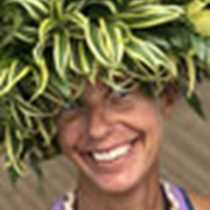This morning the National Geographic Explorer slipped from the grip of the fast ice where we spent the night in Wilhelmina Bay. Cruising down the Gerlache Strait we rounded the bend into the Errera Channel where we spent the day exploring ice and gentoo penguin colonies. Our first landing at Cuverville Island was a bit brisk but that did not stop the intrepid from climbing up the snowy slopes for the reward of a view and to butt-slide down the hill. For those who chose to explore the lowlands, the largest gentoo colony on the peninsula was full of fascinating interactions. Zodiac cruisers bundled up for a beautiful cruise among the ice that draws people to this end of the world.
After lunch, we explored Danco Island, located a little further down the channel. For those that climbed to the top of this 590-foot-high island, the views did not disappoint. Glaciers descending in every direction off the Arctowski Peninsula and Rongé Island and the ice-choked channel full of tabular icebergs were sights we will long remember. To top off a perfect Thanksgiving our whale biologists Bob and Jared found some little b killer whales for us to view and enjoy after dinner.
The place names of this part of the peninsula all date back to the Belgica expedition of 1897 which was the first truly scientific expedition to visit Antarctica. Under the command of Adrien de Gerlache (Gerlache Strait) was an internationally mixed crew from Belgium, Poland, Romania, Norway (Roald Amundsen), and one American (Dr. Frederick Cook who later claimed to reach North Pole in 1908). While his intentions of landing a wintering party in the Ross Sea area were not achieved due to a late departure, his penetrations south to 71 degrees on the west side of the peninsula led to other adventures for the crew of 19 (all but four of whom had intended to overwinter). Stuck in the ice the Belgica spent a year helplessly drifting in the Bellighausen Sea. The crew did reasonably well for the first few weeks but when the sun set on May 16, 1898 the tides began to change. Emile Danco (Danco Island), the magnetic observer and geophysicist, died of a pre-existing heart condition. Scurvy and polar night-induced depression led some of the crew to go insane. But 2nd mate Roald Amundsen was in his element and studied ice conditions and equipment. This experience would later lead to his success on his own expeditions sailing through the Northwest Passage and becoming the first person to reach the South Pole. When it began to look like they might be faced with a second year in the ice they used saws to create a channel to open water. After many set-backs the ship was finally freed and headed straight for Punta Arenas. This involuntary wintering in the ice became the first winter spent by humans south of the Antarctic Circle. Their accomplishments are noteworthy as not only did they discover the largest terrestrial animal on the continent a wingless fly, Belgica antarctic but the Polish geologist Henryl Arctowski (Arctowski Peninsula) made bathymetric measurements that suggested the peninsula was an extension of the Andes through the Scotia Arc. Needless to say this became an important piece in assembling the jigsaw puzzle of plate tectonics.







